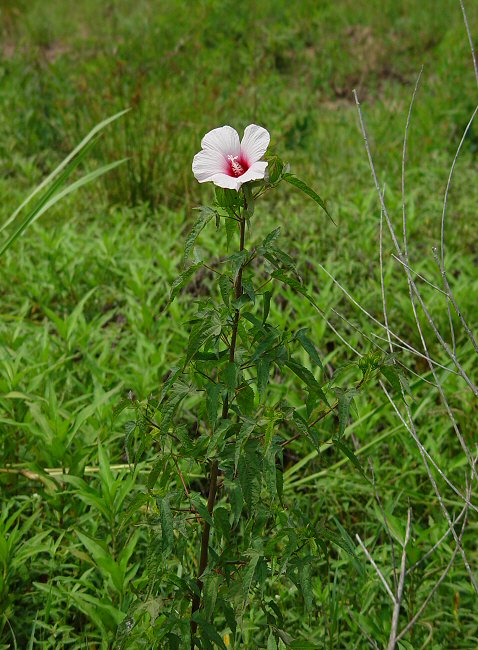Hibiscus laevis All.
Rose Mallow

Native
CC = 4
CW = -5
MOC = 53
© DETenaglia
Hibiscus laevis All.Rose Mallow | |
 |
Native CC = 4 CW = -5 MOC = 53 |
© DETenaglia |
|
Family - Malvaceae Habit - Perennial forb, sometimes slightly woody at the base. Stems - Ascending to erect, to 2.0 m, branching, often rooting at the lowest nodes, glabrous, glaucous.
Leaves - Alternate, petiolate, mostly hastate. Petiole to 12 cm long, glabrous. Blades 4-20 cm long, ovate or less commonly elliptic-lanceolate in outline, shallowly to deeply 3-lobed at the base, less commonly unlobed, the margins relatively finely and sharply toothed, the surfaces glabrous or nearly so. Stipules shed during leaf development. Lobes acuminate to attenuate, crenate to crenate-serrate.
Inflorescence - Solitary pedunculate terminal or axillary flowers. Peduncles to 3.5 cm long, glabrous, with a joint near the middle. Bractlets subtending the calyx 8-12, 12-25 mm long, glabrous or pubescent with unbranched or fasciculate hairs along the margins.
Flowers - Calyces 25-35 mm long at flowering, becoming slightly enlarged to 40 mm and slightly inflated at fruiting, glabrous or sparsely and finely pubescent with stellate hairs along the veins. Petals 5, 6-8 cm long, joined at the base to the staminal column, white or more commonly pink, usually with dark reddish purple bases. Stamen column to 4 cm long, glandular-pubescent, white. Filaments wine-red to white, 2.0-2.5 mm long, glabrous. Anthers purple-tan, 2 mm long. Style white, pubescent at the apex, exserted from the staminal column, 5-lobed at the apex. Stigmas capitate, 2-2.5 mm broad.
Fruit - Capsules 2.2-3.2 cm long, ovoid to ovoid-cylindric, glabrous except for dense simple and fasciculate hairs along the inner side of the margins of the valves (visible after dehiscence). Seeds 12-18 per locule, 3.2-3.8 mm long, broadly kidney-shaped to nearly globose, the surface densely covered with short stiff orangish brown hairs, dark brown.
Flowering - July - October. Habitat - Bottomland forest openings, swamps, riverbanks, pond margins, sloughs, ditches, wet roadsides, sometimes growing in shallow water. Origin - Native to the U.S. Lookalikes - H. lasiocarpos. Other info. - This attractive species can be found throughout much of Missouri, though it is uncommon or absent in the Ozark region. Beyond Missouri its range occupies much of the U.S. Midwest, extending in scattered fashion to the Atlantic coast. The plant is easily recognized by its wet habitat and large, showy flowers. It is easily differentiated from its close lookalike H. lasiocarpos by its glabrous, hastate leaves. The lookalike has leaves which are usually densely hairy and lacking in basal lobes. Interestingly, although H. laevis is mostly glabrous, its seeds are hairy, whereas the hairy lookalike, H. lasiocarpos, has glabrous seeds! Photographs taken at Eufala National Wildlife Refuge, AL., 6-25-06 (DETenaglia); also along the Al Foster Trail near Glencoe, St. Louis County, MO, 10-15-2015, at Catawissa Conservation Area, Franklin County, MO, 9-5-2017, and Riverfront Park, Washington, Franklin County, MO, 10-1-2020 (SRTurner). |